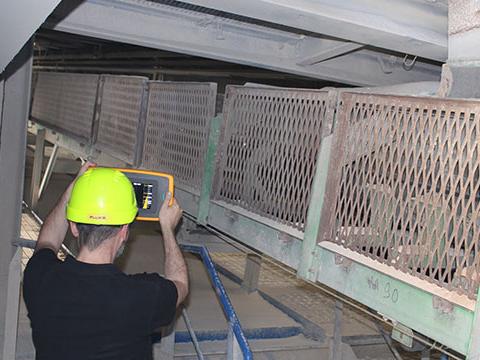
Posted to News on 21st Nov 2023, 13:30
Minimise downtime and cut repair costs while scaling up

When a company calculates that over the next five years it would expect to lose 30% of its maintenance staff but 80% of its knowledge base, alarm bells start to ring, as the experts at Fluke explain.
Across the world’s factories, warehouses, food and beverage production plants and mining/raw materials applications where conveyor belts are widely used, when maintenance engineers retire, they are taking a priceless commodity with them – their finely tuned ears.
People who had been in post for over 40 years had developed skills that could detect audible differences in conveyor systems that might indicate a fault. Replacing the capabilities provided by those ears is proving to be a major challenge for some of the globe’s biggest names in the manufacturing, logistics and raw materials sectors.
Naturally, those companies are always looking to minimise downtime and boost productivity. They simply cannot afford their conveyor systems to grind to a halt because that translates into lost revenues, delayed delivery of products and packages and dissatisfied customers who may choose to go elsewhere in highly competitive markets. Although different stakeholders within an organisation will have their own key performance indicators (KPIs), it should always be understood that downtime affects everyone in an organisation and its impact can never be overstated.
To make matters worse, along with the loss of skilled workers with decades of experience is the staggering statistic that 70% of conveyor systems are either never inspected at any level or are checked only by human sensing. This means that in today’s factories and warehouses, the vast majority of problems are only identified after they have already happened, which is clearly too late.
One key factor behind these figures is the impracticality of somebody being able to check hundreds of miles/kilometres of conveyor systems, especially in facilities that can be the size of several football pitches. The problem is even more acute in the large number of difficult to access areas that are found in most conveyor networks. In addition, in an automated factory, accessibility might be restricted by the cages that are erected around robots for safety purposes.
Acoustic visualisation
For many years, the technology of acoustic visualisation has proved itself to be highly effective in compressed air leak detection within factories and warehouses but is relatively unknown in a materials handling environment. Operators in this sector have been continually on the lookout for an effective solution that can slash downtime and cut costs but the technology to achieve those goals has never been available… until now.
Working closely with customers, Fluke has recognised that the most effective way of avoiding costly downtime is early identification of a potential issue. The earlier a likely problem is flagged up, the more a company can protect assets, minimise energy wastage and reduce the cost of repair. While there are clear direct costs associated with downtime, the indirect costs – such as having to pay over the odds for emergency repair and spare parts – can be huge. Staying ahead of the problem is vital if business continuity is the goal.
While conventional ultrasound can be a useful tool for early identification of problems, for example, it can also be subjective because not every mechanical piece of equipment is the same. Likewise, using hand-held contact-based devices was time-consuming and while fixed sensors were not scalable, limiting their usefulness and effectiveness. Fluke found that the purest way of identifying an issue was through acoustic mechanical inspection.
Acoustic imaging has been found to be far more effective than human sensing, temperature checking, thermography, vibration checking or airborne ultrasound. The technology wins out in every aspect, including user safety, ease of use and interpretation, and the ability to localise potential issues successfully. This last point means that instead of having to carry out multiple inspections to locate a single problem, it is now possible to home in on an issue accurately and rapidly.
Scalability
Acoustic imaging is also particularly suited to scalability, which is a key issue when it comes to the length and the complexity of many modern conveyor systems. Alternative technologies are also hard to implement when operators are non-trained or low-skilled, which is increasingly the case. At the same time, usability of current equipment can mean that speed of inspection can vary widely, affecting predictability and planning.
Fluke’s solution has been to add a new feature to its widely used ii910 precision acoustic imagers, a Firmware 5 update which augments the device with a MecQ facility. This simplifies the process of carrying out non-contact inspection on conveyor systems with the device capable of identifying a mechanical area of interest immediately based on ultrasound analysis and visual comparison. Once the issue is displayed on-screen, a maintenance engineer is able to capture it, document it, make annotations about it and discuss it with their maintenance planning team or share it through a reporting platform. They are then able to define second line measurement and prioritise the issue in terms of severity and add it to their schedule, if applicable.
The MecQ facility adds a new layer to the ii910’s detection capabilities, which already includes producing a screenshot or video, carrying out leak detection with LeakQ and carrying out partial discharge detection using the PDQ mode. Designed with versatility in mind, the MecQ option offers the user a choice of three different capture modes which are particularly ideal for operators with minimal training and experience.
With varying skills levels in mind, the intuitive user interface on the ii910 with MecQ has been designed for ease of operation and to enable the user to work with the device in a way that suits their requirements. The aim has been to empower the user and to make the equipment suitable for deployability over a wide range of abilities.
With no education or training required, the imager can be integrated easily into existing maintenance teams, cutting costs and saving time by enabling them to focus only on the areas that are of interest to them. There is no redundant technology, no screens to scroll through that contain irrelevant information or options. The user is in full control.
Maximising uptime
Ultimately, the goal has to be maximum uptime, to keep a machine, production line or warehouse running as efficiently as possible. Research has shown that downtime can cost up to $130,000 per hour in some industries. In conjunction with this, safety is obviously a top priority. The Fluke ii910 precision acoustic imager with MecQ gives maintenance engineers the most effective tool on the market to satisfy both these requirements.
Fluke acoustic imagers are sound cameras that include an array of 64 micro-electronic surface mount microphones to capture sound waves emanating from an object. With advanced electronics and software algorithms, sound signals (ultrasound that mechanical components produce when deterioration occurs) are converted into an image and overlaid on to the ii910’s 7-inch, 1280 x 800 pixel LCD touchscreen. The screen shows tool menu, distance indication, leak or PD quantification, palette of dB SPL scale, frequency spectrum, folder selection, battery status and date and a one-button capture image. Two interchangeable rechargeable batteries provide a combined 12 hours of operational time.
Without MecQ, maintenance engineers would have no other option but to rely on less accurate methods of detecting problems in their production line or warehouse. Those who are charged with inspecting infrastructures on a large scale have been given a tool that provides levels of freedom and flexibility that are otherwise not available. Human sensing certainly played an important role in the detection of potential problems within a range of facilities but those days have gone. Today’s factories, warehouses and mining facilities demand a simple but powerful means of visually detecting issues quickly and easily before they cause unwanted downtime.
One customer has already fed back to Fluke that with the MecQ option the ii910 precision acoustic imager, which offers them seamless integration with their existing leak and partial discharge detection tools, has gone from being a ‘nice to have’ product to a ‘must have’ solution that is helping them to scale up while reducing downtime costs in their facilities. For this customer, Fluke’s Firmware 5 upgrade has simplified what would typically be a highly complex and time-consuming inspection and maintenance operation. Other companies are now reporting the same benefits.








